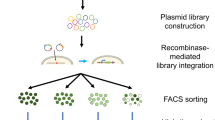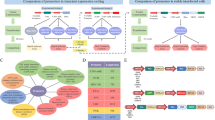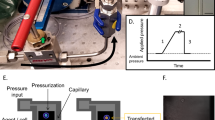Abstract
The relatively low levels of transfection that can be achieved by current gene-delivery systems have limited the therapeutic utility of gene transfer. This is especially true for nonviral gene-delivery systems, where the levels of gene expression achieved are usually below the levels achieved by viral gene transfer systems. One strategy for increasing gene expression is to design a cytoplasmic expression system that does not require nuclear delivery for gene expression to occur. This can be achieved through the use of an autocatalytic cytoplasmic expression system using phage RNA polymerases. Here we describe cytoplasmic expression systems that yield increased levels of gene expression following in vitro transfection. We demonstrate direct evidence for an exponential, autocatalytic increase in gene expression using autogenes, as well as levels of reporter gene expression that are 20-fold higher than standard CMV-based nuclear expression systems. The development of a high-efficiency plasmid-based expression system could significantly improve the gene expression properties of nonviral gene-delivery systems, thereby increasing their clinical utility.
This is a preview of subscription content, access via your institution
Access options
Subscribe to this journal
Receive 12 print issues and online access
$259.00 per year
only $21.58 per issue
Buy this article
- Purchase on Springer Link
- Instant access to full article PDF
Prices may be subject to local taxes which are calculated during checkout









Similar content being viewed by others
References
Gao X, Huang L . Cytoplasmic expression of a reporter gene by co-delivery of T7 RNA-polymerase and T7 promoter sequence with cationic liposomes. Nucleic Acids Res 1993; 21: 2867–2872.
Elroy-Stein O, Moss B . Cytoplasmic expression system based on constitutive synthesis of bacteriophage T7 RNA polymerase in mammalian cells. Proc Natl Acad Sci USA 1990; 87: 6743–6747.
Dubendorff JW, Studier FW . Creation of a T7 autogene. Cloning and expression of the gene for bacteriophage T7 RNA polymerase under control of its cognate promoter. J Mol Biol 1991; 219: 61–68.
Capecchi MR . High efficiency transformation by direct microinjection of DNA into cultured mammalian cells. Cell 1980; 22 (Part 2): 479–488.
Zabner J et al. Cellular and molecular barriers to gene transfer by a cationic lipid. J Biol Chem 1995; 270: 18997–19007.
Wilke M et al. Efficacy of a peptide-based gene delivery system depends on mitotic activity. Gene Therapy 1996; 3: 1133–1142.
Coonrod A, Li FQ, Horwitz M . On the mechanism of DNA transfection: efficient gene transfer without viruses. Gene Therapy 1997; 4: 1313–1321.
Lechardeur D et al. Metabolic instability of plasmid DNA in the cytosol: a potential barrier to gene transfer. Gene Therapy 1999; 6: 492–497.
Chamberlin M, McGrath J, Waskell L . New RNA polymerase from Escherichia coli infected with bacteriophage T7. Nature 1970; 228: 227–231.
Dunn JJ, Bautz FA, Bautz EK . Different template specificities of phage T3 and T7 RNA polymerases. Nat New Biol 1971; 230: 94–96.
Brisson M et al. A novel T7 RNA polymerase autogene for efficient cytoplasmic expression of target genes. Gene Therapy 1999; 6: 263–270.
Kaempfer R, Rosen H, Israeli R . Translational control: recognition of the methylated 5′ end and an internal sequence in eukaryotic mRNA by the initiation factor that binds methionyl-tRNAfMet. Proc Natl Acad Sci USA 1978; 75: 650–654.
Drummond DR, Armstrong J, Colman A . The effect of capping and polyadenylation on the stability, movement and translation of synthetic messenger RNAs in Xenopus oocytes. Nucleic Acids Res 1985; 13: 7375–7394.
Jang SK, Wimmer E . Cap-independent translation of encephalomyocarditis virus RNA: structural elements of the internal ribosomal entry site and involvement of a cellular 57-kD RNA-binding protein. Genes Dev 1990; 4: 1560–1572.
Deng H, Wolff JA . Self-amplifying expression from the T7 promoter in 3T3 mouse fibroblasts. Gene 1994; 143: 245–249.
Kreiss P et al. Plasmid DNA size does not affect the physicochemical properties of lipoplexes but modulates gene transfer efficiency. Nucleic Acids Res 1999; 27: 3792–3798.
Bernstein P, Ross J . Poly(A), poly(A) binding protein and the regulation of mRNA stability. Trends Biochem Sci 1989; 14: 373–377.
Sachs A . The role of poly(A) in the translation and stability of mRNA. Curr Opin Cell Biol 1990; 2: 1092–1098.
Jackson RJ, Standart N . Do the poly(A) tail and 3′ untranslated region control mRNA translation? Cell 1990; 62: 15–24.
Acknowledgements
We thank Dr Jon Wolff (Waisman Center, WI) for providing the autogene-encoding plasmid pT7-G1 and EMC-Luc, and Dr Paul Fisher (Department of Pharmacological Sciences, State University of New York at Stoney Brook) for providing the goat anti-T7 RNAP antibodies. These studies were funded by a grant from the Canadian Institutes of Health Research (CIHR) and Protiva Biotherapeutics Inc. JF is a recipient of a Science Council of British Columbia G.R.E.A.T. scholarship.
Author information
Authors and Affiliations
Rights and permissions
About this article
Cite this article
Finn, J., Lee, A., MacLachlan, I. et al. An enhanced autogene-based dual-promoter cytoplasmic expression system yields increased gene expression. Gene Ther 11, 276–283 (2004). https://doi.org/10.1038/sj.gt.3302172
Received:
Accepted:
Published:
Issue Date:
DOI: https://doi.org/10.1038/sj.gt.3302172
Keywords
This article is cited by
-
A T7 autogene-based hybrid mRNA/DNA system for long-term shRNA expression in cytoplasm without inefficient nuclear entry
Scientific Reports (2019)
-
Construction and Quantitative Evaluation of a Dual Specific Promoter System for Monitoring the Expression Status of Stra8 and c-kit Genes
Molecular Biotechnology (2014)
-
Investigation of factors responsible for cell line cytoplasmic expression differences
BMC Molecular Biology (2005)
-
Gene Therapy Progress and Prospects: Recent progress in transgene and RNAi expression cassettes
Gene Therapy (2005)



